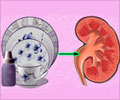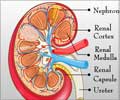In patients with kidney failure who initiated peritoneal dialysis, scientists have identified substantial volume overload, or too much fluid in the body.

‘Volume overload tended to improve over time after starting dialysis, but was at all times was higher in males vs. females and in patients with diabetes vs. those without.’





Individuals with kidney failure who are undergoing hemodialysis or peritoneal dialysis often experience fluid overload. To examine the implications of this condition, Wim Van Biesen, MD, PhD (University Hospital Ghent, in Belgium) and his colleagues designed a study to assess patients' health and fluid volume over time after initiating peritoneal dialysis. It's thought that actively managing volume overload may reduce the risk of technique failure (transfer from peritoneal dialysis to hemodialysis) and prolong patient survival. In the study of 1,054 patients from 28 countries who were examined every 3 months, volume overload before the start of dialysis amounted to an average of 1.9 L and decreased to 1.2 L during the first year. After 3 years of follow-up, the average relative volume overload in patients was lower than at the start in participants from all regions except those of Latin American, where it increased. The investigators concluded that volume overload is already present before the start of dialysis, and it tends to improve over the first 6 months and stabilize afterwards.
At all time points, males and participants with diabetes were at a higher risk of experiencing volume overload. Also, volume overload was associated with a higher risk of premature death. The study revealed different treatment practices to address volume overload across dialysis centres and regions.
"We intended to associate practices of peritoneal dialysis--use of hypertonic exchanges, use of automated peritoneal dialysis vs. continuous ambulatory peritoneal dialysis, use of icodextrin, and use of diuretics--with technique failure. Our main finding is that the association between technique failure and fluid overload is dependent upon centre size and thus presumably experience within the treating centre," said Dr. Van Biesen.
In an accompanying Patient Voice editorial, Shari Gilford shared her experience of peritoneal dialysis, both ambulatory and automated, for 7 years. She also questioned why patients in Latin America had a different outcome than those from other regions.
Advertisement
Source-Eurekalert














